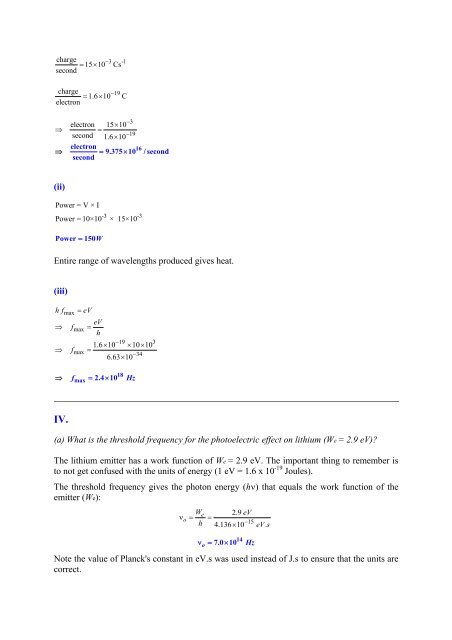X-Ray Fluorescence Analytical Techniques - CNSTN : Centre ...
X-Ray Fluorescence Analytical Techniques - CNSTN : Centre ...
X-Ray Fluorescence Analytical Techniques - CNSTN : Centre ...
Create successful ePaper yourself
Turn your PDF publications into a flip-book with our unique Google optimized e-Paper software.
charge<br />
= 15× 10 Cs<br />
second<br />
−3<br />
-1<br />
charge<br />
−19<br />
= 1.6× 10 C<br />
electron<br />
−3<br />
electron 15× 10<br />
⇒ =<br />
second −19<br />
1.6× 10<br />
electron<br />
16<br />
⇒ = 9.375× 10 / second<br />
second<br />
(ii)<br />
Power = V × I<br />
-3 -3<br />
Power = 10×10 × 15×10<br />
Power = 150W<br />
Entire range of wavelengths produced gives heat.<br />
(iii)<br />
hfmax = eV<br />
eV<br />
⇒ fmax<br />
=<br />
h<br />
−19<br />
3<br />
1.6× 10 × 10× 10<br />
⇒ fmax<br />
=<br />
−34<br />
6.63× 10<br />
18<br />
⇒ fmax = 2.4× 10 Hz<br />
IV.<br />
(a) What is the threshold frequency for the photoelectric effect on lithium (We = 2.9 eV)?<br />
The lithium emitter has a work function of We = 2.9 eV. The important thing to remember is<br />
to not get confused with the units of energy (1 eV = 1.6 x 10 -19 Joules).<br />
The threshold frequency gives the photon energy (hν) that equals the work function of the<br />
emitter (We):<br />
We 2.9 eV<br />
ν o = =<br />
h −15<br />
4.136× 10 eV. s<br />
14<br />
ν o = 7.0× 10 Hz<br />
Note the value of Planck's constant in eV.s was used instead of J.s to ensure that the units are<br />
correct.


